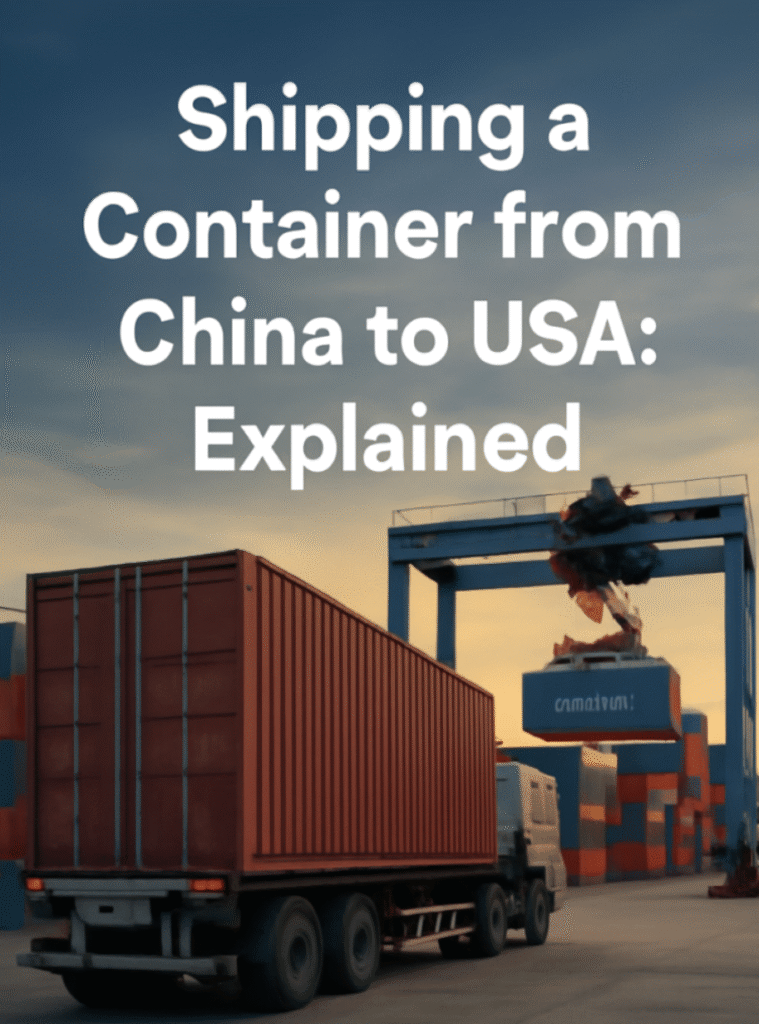Why Container Shipping from China Still Matters
If you’re in the business of importing goods or scaling your operations, shipping containers from China to the USA remains one of the most cost-effective ways to move large quantities of products. While faster air freight options are available, the cost-effectiveness and scalability of ocean freight continue to be invaluable for businesses looking to maximize profitability.
Whether you’re importing electronics, furniture, or fashion goods, choosing the right shipping method can directly impact your bottom line. Understanding the container shipping process from China to the USA not only helps you reduce costs but also ensures on-time delivery, avoiding unnecessary delays.
In this guide, we’ll break down every step of the process of container shipping from China to USA, highlight hidden fees you might miss, and provide practical tips to help you plan smarter logistics for greater efficiency.
Step-by-Step: How the Container Shipping Process Works
Shipping a container from China to the USA can seem overwhelming, but understanding the key stages of the process can make things feel more manageable. Here’s how it typically works:
- Factory Pickup
Your goods are collected directly from the supplier’s warehouse. A trusted freight forwarder will coordinate this step seamlessly, ensuring that the right goods are picked up and delivered to the correct port. This step is crucial for timely shipments, as any delay at this stage can affect the overall delivery timeline. - Inland Transportation
A truck hauls your container to the nearest major port, such as Shanghai or Shenzhen. Efficient coordination here ensures that the container reaches the port on time, reducing the risk of unnecessary costs or delays. For large orders, it’s vital that this step is handled properly to maintain a smooth process. - Export Customs Clearance
Paperwork is prepared, duties are paid, and your cargo is cleared for departure. At this stage, it’s essential to have accurate documentation to avoid delays and costly penalties. A reliable freight forwarder will assist in ensuring that all customs documents are in order to avoid any holdups. - Ocean Freight
Your container is loaded onto a vessel and begins its journey across the Pacific. The shipping time from China to U.S. ports typically takes between 18 to 30 days, depending on the specific route and conditions. Throughout this process, the freight forwarder tracks your shipment, ensuring you’re updated on its progress so you’re never in the dark. - Arrival at U.S. Port
Once your container arrives at ports like Los Angeles or Long Beach, it will undergo import customs clearance. Improper paperwork or delays at this stage can result in additional fees, so it’s important to have a clear understanding of the customs procedures. - Final Delivery
After clearance, your container is trucked to your warehouse, fulfillment center, or final destination. Real-time tracking tools help ensure transparency throughout the delivery process, so you’re always aware of your shipment’s location.
By partnering with a knowledgeable freight forwarder, such as Gorto, the shipping process becomes more predictable. Their expertise ensures that you can focus on growing your business without worrying about delays or unexpected fees.
Choosing Between a 20ft and 40ft Container
When shipping a container from China to the USA, size matters—literally. Picking the right container can save you thousands and avoid wasted space or unexpected fees. If you’re curious about typical costs for a 20-foot container, click here for more details.
Here’s a quick breakdown:
- 20ft Container
Ideal for smaller shipments or heavier goods like machinery, metals, or dense products.
➔ Capacity: About 28–30 cubic meters (roughly 10 standard pallets). - 40ft Container
Best for larger, bulkier shipments like furniture, textiles, or multiple product lines.
➔ Capacity: About 58–60 cubic meters (up to 20 standard pallets).
Tip:
If your shipment is lightweight but bulky, a 40ft container offers better value per cubic meter. If your goods are heavy and compact, a 20ft container might be enough—and cheaper overall.
At Gorto, we help businesses select the most cost-effective container size, ensuring that your shipment arrives safely and without unnecessary overhead. A key element of their service is not just the shipping process itself but ensuring that clients get the most out of every cubic meter of space.
Hidden Costs You Might Overlook
Getting a quote for shipping a container from China to the USA is just the start. To avoid nasty surprises, it’s crucial to understand the hidden costs that don’t always show up in the initial freight estimate.
Here are some common extra charges importers often miss:
- Customs Duties and Taxes
Even if your freight cost looks low, you’ll still need to pay U.S. import duties based on product type (HS code) and value. Many freight forwarders, such as Gorto, can help navigate this step to ensure accuracy. This might include advising on which HS codes to use for your goods to minimize costs. - Port Handling and Terminal Fees
U.S. ports charge fees for unloading containers, storage, and handling. These are billed separately from your ocean freight, so it’s important to check the terms when you receive your quote. These charges can add up quickly, especially if there are delays. - Inland Trucking Charges
Moving your container from the port to your warehouse adds an extra cost, especially if the distance is long. Working with a freight partner who knows the best routes can help keep these costs down. Gorto provides routes optimized for cost-effectiveness and speed, helping clients save on long-distance transport. - Documentation and Admin Fees
Export documents, customs filing, and paperwork processing usually come with small charges that add up. Some freight forwarders include these fees in their quotes, while others charge separately. - Demurrage and Detention Fees
If your container isn’t picked up or returned within the allowed free days at the port, storage fees can rack up fast. These charges are especially relevant for containers that sit idle for an extended period. - Cargo Insurance
While optional, shipping insurance is highly recommended. It protects your goods from damage or loss during transit. Though it’s an added cost, it’s a relatively small price for peace of mind, especially for high-value shipments.
Smart importers plan for these costs early to avoid budgeting surprises. Working with a trusted partner, such as Gorto, allows you to avoid unexpected costs and streamline the entire process from start to finish.
Tips to Reduce Your China–USA Shipping Expenses
Shipping a container from China to the USA doesn’t have to drain your budget. Smart planning and a few simple strategies can help you cut costs without sacrificing reliability.
Here’s how experienced importers keep expenses in check:
- 1. Consolidate Shipments
If your cargo doesn’t fill a container, consider LCL (Less than Container Load) or consolidating shipments with other cargo to maximize container space and share costs. - 2. Ship During Off-Peak Seasons
Avoid peak times like before Chinese New Year, Golden Week, or Black Friday prep season. Shipping during quieter months often means better rates and faster handling. - 3. Choose Ports Strategically
Landing your container at a port closer to your warehouse can reduce inland trucking fees. Sometimes paying slightly more for ocean freight saves a lot on domestic transport. - 4. Book Early, Lock Better Rates
Ocean freight prices fluctuate fast. Booking a few weeks in advance can secure better deals—especially when carriers start to fill up. - 5. Work with a Trusted Freight Forwarder
A good forwarder doesn’t just move cargo—they help you find smart ways to save, bundle services, and avoid unnecessary fees. Gorto’s expert team helps optimize every step of your supply chain, ensuring cost-effective solutions that match your needs.
Conclusion: Plan Smart, Ship Confidently
Shipping a container from China to the USA may seem complex—but with clear planning and the right support, it becomes a strategic advantage.
From container size selection to customs handling and last-mile delivery, every step in the process matters. By understanding where hidden costs hide and how to optimize your route, importers can reduce risk, control budgets, and ensure timely delivery.
For growing businesses, working with experienced freight partners can make all the difference.
Freight resources like GortoFreight provide insights, tools, and guidance that help you navigate the shipping process with greater confidence and clarity.




